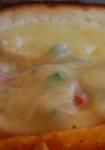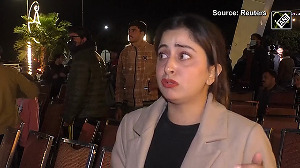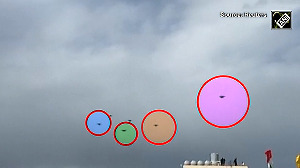Today, he lies in an unknown grave in a corner of a farmer's field in Pakistan, having given his all for his country.
A riveting excerpt from Ian Cardozo's Beyond Fear: True Stories on Life in the Indian Armed Forces.

Squadron Leader A B 'Tubby' Devayya took off on a mission during the 1965 War and never returned.
Devayya had joined the No. 1 Squadron in Adampur just before the onset of the war. Orders from the IAF Command Headquarters went out late on the night of 6 September to Adampur and Halwara for the Mystere and Hunter squadrons to plan strikes against PAF airbases.
Devayya was itching to confront the enemy. However, because he was surplus to the squadron at Adampur, he was placed in reserve and detailed as a standby, which meant that he would participate in the raid only if one of the aircraft raiding Sargodha could not get airborne.
Wing Commander 'Omi' Taneja, the Squadron Commander, commenced the briefing at 0415 hours.
'I want to make it clear that you have just enough fuel to hit your targets and get back. You will not have the luxury of a second pass over the target area, so make sure you keep your eyes open and access your targets as you go in. The success of the raid will depend on the number of enemy aircraft and vital installations destroyed.'
After the second wave of four aircraft had rolled, one of the standby aircraft suddenly moved on to the runway. This was Tubby Devayya who had jumped the gun and had already got airborne. He just could not wait to confront the enemy.
It was still half-light at Sargodha and much darker than anticipated. Its fighters on combat air patrol (CAP) for airfield defence went on alert, but before they could react, Taneja and his aircraft were already over the Sargodha airfield.
Taneja led the first dive on to the airfield. As he pulled out of his dive, he noticed two Sabres and an F-104 Starfighter parked further on the operational readiness platform (ORP). Taneja then broke radio silence to inform the second wave to attack them.
He radioed, 'Red Leader to Strike Formation, 2 Sabres and one Starfighter on ORP. Engage and destroy.'
However, the light conditions were too poor for the second wave to see the aircraft indicated by Taneja, so they attacked other targets.
When Taneja turned back for the base, Devayya was at the tail end of the group.
In the meantime, PAF Starfighters, alerted by Pakistan's Sakesar radar station, scrambled and were directed towards Sargodha.
A Pakistani F-104 Starfighter, flown by Flight Lieutenant Amjad Hussain, made visual contact with Sargodha after he saw the sky lit up by PAF ground defences.
By the time the Starfighters reached the scene of action, the Mysteres had exited the airfield and were heading towards India.
Devayya was the last one out of Sargodha and the first one to be spotted by the F-104 Starfighter piloted by Hussain.
Devayya had two options. First, he could face the Starfighter head-on and fight it out, in which case, even if he survived, he would have no fuel left to fly across the border back to India. The second option was to evade the pursuing Starfighter.
IAF pilots had been instructed not to indulge in personal heroics and instead prioritize the ability to fight again another day. Devayya was, however, of a different breed.
Not fighting the enemy was not an option for him.
Ignoring the superiority of the Starfighter, Devayya went after Hussain and began to attack him with unusual ferocity. Hussain used the superior power of the Starfighter to lift the combat from ground level to 7000 ft in order to gain more room for manoeuvring.
Devayya, however, locked on to the Starfighter and doggedly followed it all the way up, showing considerable courage in doing so because his rate of climb was much slower than the Starfighter.
Hussain was aware that his advantage in speed would make it difficult to close in on the Mystere in his bid to destroy it, and so he was forced to do a 'yo-yo' (bouncing up and down) to prevent an overshoot and managed to get behind Devayya.
He closed in on the Mystere, using his afterburner and, having got Devayya in his sights, fired a burst from the Starfighter's deadly six-barrelled 20-mm Vulcan revolver cannon.
Devayya's Mystere broke to the right and appeared to pass through the deadly stream of bullets. Hussain broke off the engagement, certain that the Mystere was destroyed.

Although the Mystere had received several hits, it was not disabled. Devayya had survived the attack and his aircraft was still flyable. There was still a chance to fly home and if his fuel ran out, he could have ejected safely over Indian territory.
Devayya ignored that option. He decided to destroy the Starfighter no matter the odds.
Hussain spotted the Mystere when it was turning to get behind him and was under the impression that this was another Mystere that was coming after him after he had destroyed the first one.
He was unaware that Devayya had survived his Vulcan onslaught and was now coming after him again.
At this stage, Hussain made a mistake. He reduced his speed in an attempt to out-turn his determined opponent to deliver the final blow.
Devayya saw his opportunity, closed in and found the Starfighter in his sights. He pressed home his attack and scored several hits on the Starfighter with his 2 x 30 mm DEFA cannons mounted on either side of the Mystere's fuselage.
This was the first and only Mach-2 Starfighter to be destroyed in air combat during the 1965 War. Devayya's successful destruction of a Starfighter was an extraordinary feat by any standard.
At Kot Naka village in Pakistan, about five miles south of Pindi Bhattian Tehsil, the farmers were out in the fields about to start their chores when they saw the two aircraft approaching them from the direction of Sargodha.
They watched in fascination and awe as the two aircraft wheeled, dived and turned while fighting to get the better of each other. The sound of the aircrafts' cannons reached them, and they wondered how this contest would end.
Then suddenly, they saw both aircraft fall out of the sky like leaves from a tree. One of the pilots came down by parachute, and the other aircraft went down across the Jang Canal. The pilot of this aircraft had failed to eject. His body was found intact, thrown clear of the wreckage. He was later buried by the villagers in the fields.
It was Squadron Leader Tubby Devayya.
Back in Adampur, an anxious Taneja was waiting for Devayya to join the mission debrief. Everyone was under the impression that Devayya was probably taking his time.
After a while, it was found that Devayya had not returned. Devayya was eventually listed as 'Missing in action.'

Declared dead seven years later, Devayya would have remained an unsung hero had it not been for John Fricker's Battle for Pakistan: The Air War of 1965 (published in Pakistan in 1979), which narrated the story of this air battle.
It was only in 1980 that Group Captain Taneja, VrC, read Fricker's account about the details of Hussain's admission of being shot down by an IAF Mystere over Sargodha on the morning of 7 September 1965.
Taneja knew better than anyone else that no other Mystere pilot had had air combat with a Starfighter that fateful morning of 7 September 1965.
He wrote to the Chief of Air Staff, strongly recommending that Devayya's gallantry be recognized by the award of a posthumous Maha Vir Chakra.
It took the Air Force eight more years to conduct a thorough investigation before recommending Devayya for the award.
On that basis, Squadron Leader Tubby Devayya was posthumously awarded the Maha Vir Chakra on 23 April 1988, 23 years after his exceptional act of conspicuous gallantry and fighting spirit well beyond the call of duty, against overwhelming odds and at the cost of his own life.
Today, he lies in an unknown grave in a corner of a farmer's field in Pakistan, having given his all for his country.
Excerpted from Beyond Fear: True Stories on Life in the Indian Armed Forces by Ian Cardozo, with the kind permission of the publishers, Penguin Random House India.
Feature Presentation: Aslam Hunani/Rediff.com











 © 2025
© 2025